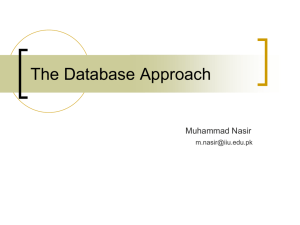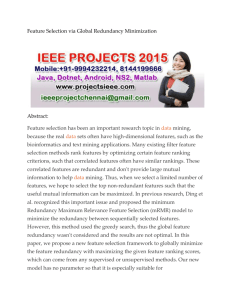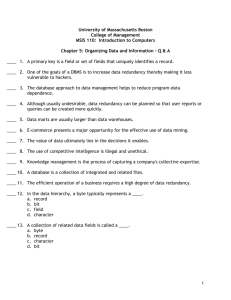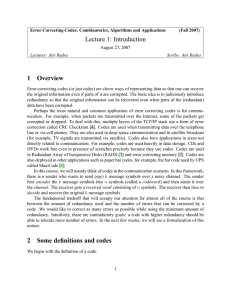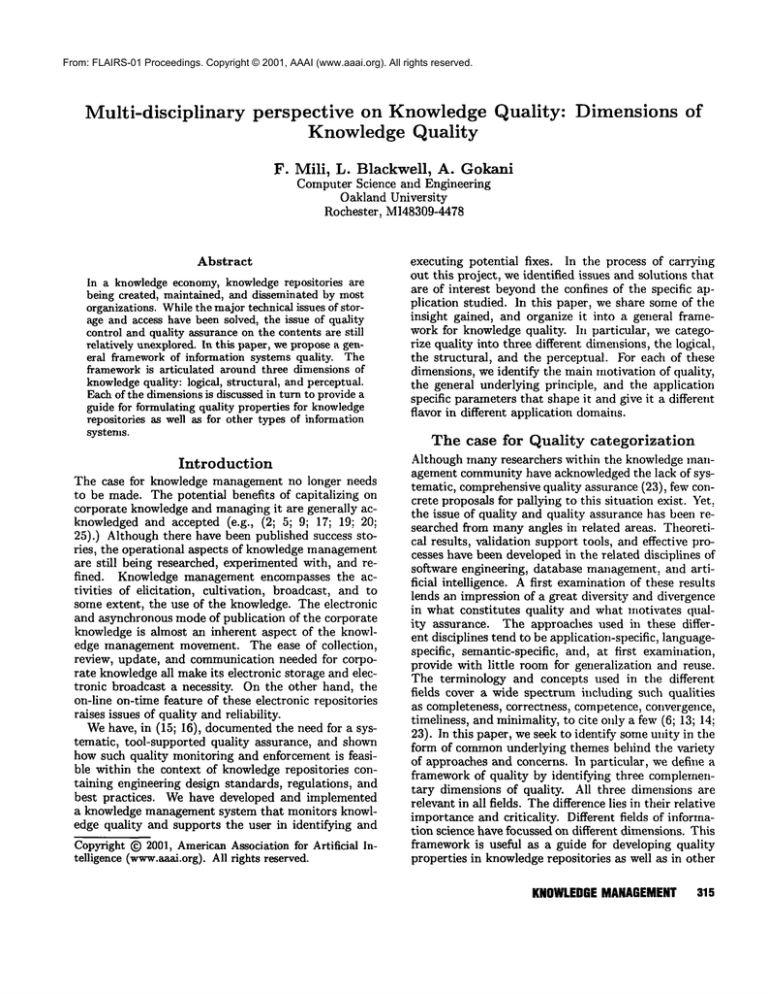
From: FLAIRS-01 Proceedings. Copyright © 2001, AAAI (www.aaai.org). All rights reserved.
Multi-disciplinary
perspective on Knowledge Quality:
Knowledge Quality
Dimensions
of
F. Mill, L. Blackwell, A. Gokani
Computer Science and Engineering
Oakland University
Rochester, M]48309-4478
Abstract
In a knowledgeeconomy,knowledgerepositories are
being created, maintained, and disseminated by most
organizations. Whilethe majortechnical issues of storage and access have been solved, the issue of quality
control and quality assurance on the contents are still
relatively unexplored. In this paper, we propose a general frameworkof information systems quality. The
frameworkis articulated around three dimensions of
knowledgequality: logical, structural, and perceptual.
Eachof the dimensionsis discussed in turn to provide a
guide for formulating quality properties for knowledge
repositories as well as for other types of information
systems.
Introduction
The case for knowledge management no longer needs
to be made. The potential benefits of capitalizing on
corporate knowledge and managing it are generally acknowledged and accepted (e.g., (2; 5; 9; 17; 19; 20;
25).) Although there have been published success stories, the operational aspects of knowledge management
are still being researched, experimented with, and refined. Knowledge management encompasses the activities of elicitation, cultivation, broadcast, and to
some extent, the use of the knowledge. The electronic
and asynchronous mode of publication of the corporate
knowledge is almost an inherent aspect of the knowledge management movement. The ease of collection,
review, update, and communication needed for corporate knowledgeall make its electronic storage and electronic broadcast a necessity. On the other hand, the
on-line on-time feature of these electronic repositories
raises issues of quality and reliability.
Wehave, in (15; 16), documentedthe need for a systematic, tool-supported quality assurance, and shown
how such quality monitoring and enforcement is feasible within the context of knowledge repositories containing engineering design standards, regulations, and
best practices.
We have developed and implemented
a knowledge management system that monitors knowledge quality and supports the user in identifying and
Copyright © 2001, AmericanAssociation for Artificial Intelligence (www.aaai.org).All rights reserved.
executing potential fixes. In the process of carrying
out this project, we identified issues and solutions that.
are of interest beyond the confines of the specific application studied. In this paper, we share some of the
insight gained, and organize it into a general framework for knowledge quality. In particular, we categorize quality into three different dimensions, the logical,
the structural, and the perceptual. For each of these
dimensions, we identify the main motivation of quality,
the general underlying principle, and the application
specific parameters that shape it and give it a different
flavor in different application domains.
The case for Quality
categorization
Although many researchers within the knowledge management community have acknowledged the lack of systematic, comprehensive quality assurance (23), few concrete proposals for pallying to this situation exist. Yet,
the issue of quality and quality assurance has been researched from many angles in related areas. Theoretical results, validation support tools, and effective processes have been developed in the related disciplines of
software engineering, database management, and artificial intelligence. A first examination of these results
lends an impression of a great diversity and divergence
in what constitutes quality and what motivates quality assurance. The approaches used in these different disciplines tend to be application-specific, languagespecific, semantic-specific, and, at first examination,
provide with little room for generalization and reuse.
The terminology and concepts used in the different
fields cover a wide spectrum including such qualities
as completeness, correctness, competence, convergence,
timeliness, and minimality, to cite only a few (6; 13; 14;
23). In this paper, we seek to identify someunity in the
form of commonunderlying themes behind the variety
of approaches and concerns. In particular, we define a
framework of quality by identifying three complementary dimensions of quality. All three dimensions are
relevant in all fields. The difference lies in their relative
importance and criticality.
Different fields of information science have focussed on different dimensions. This
framework is useful as a guide for developing quality
properties in knowledgerepositories as well as in other
KNOWLEDGE
MANAGEMENT 316
fields.
The Logical
dimension
of quality
The ultimate quality of any informational item is its
correctness and veracity. The correctness of a computer
system is defined relative to a specification or expectation. Program verification can be fully formalized,
proved, and maintained (14). For data and knowledge
repositories, veracity rather than correctness capture
the logical quality. Veracity characterizes a knowledge
or data repository that is a faithful reflection of the
world that it is meant to represent, i.e. the repository
"states the truth, all the truth, and nothing but
the truth."
Such utopic criterion, although highly desirable, is generally impossible to verify or enforce as it makesreference to an external unaccessible entity. In other words,
because veracity is an extrinsic quality, it cannot be established internally. It can only be approximated with
other intrinsic properties. In practice, intrinsic criteria are identified and used instead. By being intrinsic,
these criteria can be assessed without referring to some
outside entity, but they are only indicators of quality.
Their absence (when they are not met) is indicative
of lack of quality, while their presence only gives some
level of confidence in the quality of the artifact but does
not constitute a full warranty. For example, when considering a formal specification, the presence of a logical
"fault" such as inconsistency (7), incompleteness (6),
divergence (13), or safety violation (10) is indicative
lack of quality, yet a specification with none of these
faults is not necessarily valid. Similarly, the presence of
type mismatches in a Pascal program are an indication
of a problem, yet the absence of mismatches tells us
verylittle.
In general, given an information system expressed in
somemodelM, the intrinsic logical qualities of the system are the expression of the absence of violation of the
model’s axioms and rules. In other words, the quality
properties are anchored in a set of axioms that are inherent to the model or the language. Weillustrate this
from a variety of systems.
Relational Databases: In the relational
model of
databases, there are two primary axioms intrinsic to
the model, the entity integrity, and the referential integrity, stating respectively, that relations are sets,
and thus allow no repetitions; and that associations
must be expressed with valid references. In addition to the modelsaxioms (or integrity constraints as
they are generally called), the model allows domainspecific, user-defined integrity constraints. The expression of these constraints is of interest to theextent
that the system (DBMS)automatically monitors and
enforces these quality axioms.
Object Oriented Databases: The object oriented
model has muchricher semantics than the relational
model. As a result, it is associated with a larger
316
FLAIRS-2001
number of axioms. The axiomatization of the object model received particular attention within the
domain of database schema evolution. Because object databases are used in domains where the schema
is expected to change frequently, the need for a system supported monitoring and enforcement of some
level of schemacorrectness is critical. All proposals
related to object schema evolution center around the
definition of a set of axioms (or invariants) (8;
22; 24). Most of these logical consistency properties
center around the classification hierarchy ensuring it
remains a partial order, and that classification associations are consistent with its axiomatization.
Knowledge Bases: Knowledge bases can be seen as
formal versions of task-specific knowledge repositories. Even though they are represented in a formal
language and benefit from careful, manual crafting,
knowledge bases do also raise the need for an automatic monitoring of quality. In addition to consistency with the semantics of the formal logics, other
qualities of completeness (coverage) have also been
used.
Knowledge Repositories:
When the knowledge is
represented in an informal language, inconsistencies
and contradictions are hard to detect. In (16),
have used an augmented object model to represent
engineering design knowledge, and defined a set of
axioms defining the semantics of the model.
In summary, logical quality is the extent to which
the artifact is expressed "correctly" within the model
or language. The extent to which logical quality can
be enforced and monitored is a direct factor of the extent to which the language or model is formalized. It
is muchharder to detect a contradiction in a statement
expressed in some natural language, for example, than
it is to detect a contradiction in the same statement
expressed in a formal language. Whenthe model’s axioms are formal, the monitoring of quality can be performed in an automatic manner and integrated within
the knowledge management tool.
The Structural
dimension
of quality
In the same way that logical quality is the first thing
that comes to mind when we think of knowledge base
quality, structural quality is the first that comes to
mind when we think of software quality. Structural
quality is also prevalent in database. Structural quality is to a large extent an evolution- and maintenancerelated quality. Whensystems or artifacts are meant
to be designed once, validated, and then used forever
unchanged,logical quality is all that is needed. For software artifacts, however, this is hardly ever the case. As
a result, there are generally at least two layers of quality that are used. The first layer, logical quality reflects
the fact that a system is correct/valid/operational. The
second layer, structural quality, is needed to reflect the
fact that the logical quality of the artifact is relatively
easy to preserve as the system evolves and changes over
time.
In the programmingrealm, software quality refers to
such qualities as readability, modularity, abstraction,
high cohesion of individual units or subsystems, and low
coupling between different units. In software engineering, we find the same concepts and themes recurring
at a larger scale. The concepts of high coherence and
low coupling are applied at tim subsystems level. The
concepts of modularity and abstraction are prevalent as
well, promoting reusing existing artifacts and building
reusable ones (4; 6; 3).
In the area of database, where data repositories are
updated by users whohave limited views of the overall
contents of the database, the system’s oversight over
the quality of the data is one of its most important
missions. As a result, the concept of structural quality
is well developed. Ill relational databases, structural
quality is defined as the lack of redundancy. The lack of
redundancy is reflected by the general guiding principle
that "each item of information figures in one and only
one place." This requirement ensures that a change in
one item in the database will not conflict with other
information elsewhere within the same database (1).
The above discussion identifies two subthemes within
the structural dimension of quality: modularity, and
absence of redundancy. They reflect two complementary approaches to managing the unavoidable interdependencies that exist within a system. Modularity
managesinter-dependencies by clustering related information together and separating it from other relatively
independent information. Elimination of redundancy
manages inter-dependencies by taking advantage of the
expressive power and the inference power of the language to capture the same information in the most economical way. We discuss each of theses two complementary sub-themes briefly.
Modularity is the hardest of the two to formalize and
quantify in general. There are two dimensions to modularity: The language or model in which the system is
expressed must support modularity; and the designer
must make use of this facility.
The underlying guiding principle is to divide the system into relatively self
contained and reusable subsystems, and maximize the
locality of changes. Different programming paradigms
emphasize different conceptual modules (flmctions vs.
objects for example). Individual modules can be analyzed, reasoned about, and modified relatively independently of the context in which they are used. This
requires systems to have high cohesion (to be self contained) and high level of abstraction (to be reusable).
These same qualities also contribute to the locality of
changes. The added characteristic of low coupling further enhances locality. Software engineering metrics are
used to quantify these qualities (12).
In summary, the general guideline in modularity is
to maximize self- containment of components and may
imize locality of changes. In someapplications, quantified or qualified parameters can be defined to character-
ize modularity. In those cases this quality criterion can
be automatically assessed and monitored by a system.
The second subtheme of structural quality, i.e. elimination of redundancy, has generally been captured more
formally. This may be in part, because it has been applied to more formal structures such as databases and
knowledge bases. The guideline of eliminating redundancy would be trivial if redundancy were limited to
the replication of identical information. Generally, redundancy occurs in more subtle forms. In relational
databases, a data item d is deemedredundant if it already exists in the database, or if it can be derived
from other data in the database. A set of inference rules
based on the concept of functional dependencies (reflexivity, transitivity, augmentation)is defined. These rules
are used to define the informational content -implicit
as well as explicit- of a database. A data item d is
then deemed redundant with respect to given database
if it can be derived from the data explicitly stored in the
database. In knowledgebase systems, absence of redundancy is also used as a quality criterion for knowledge.
The fact that the definition of absence redundancy
is intimately tied to the inference rules of the model or
language used is a reflection of the fact that the richer
are the semantics of the model, the more econonfical is
the expression of the information. In other words, the
more one can infer from a statement, the fewer statements one has to make. Informal languages do have a
high expressive power, but the derived information is
often ambiguous. In the realm of knowledge manage,nent, knowledgeis often expressed in semi formal langnages. The detection of redundancy or contradiction
cannot be done with certainty. Heuristics can be used
to assist users in detecting and correcting problems.
In (15), we have defined a set of "normal forms" for
the engineering design knowledge based on the rules of
inferences dictated by the associations used. In addition to the classification association and its inheritance,
we have used part-feature and assembly-component associations.
In sum, the underlying principle of elinfination of redundancy is to ensure that "each item of information
is expressed in only one place." This is materialized by
the definition of
* A set of inference rules that dictate how to derive
new information from information explicitly stored.
¯ A corresponding set of quality criteria
absence of redundancy.
The Perceptual
capturing the
dimension of quality
This ttfird dimension is relevant in those cases where the
artifact is "read" by humans. Ttfis is generally the case
in knowledge management settings.
Understandably,
perception is the least quantified and the least explored
of the three. Even though it can be totally subjective,
this dimension is critical in a knowledge management
setting where corporate workers are expected to trust
KNOWLEDGE
MANAGEMENT
317
a knowledgerepository and use it as a basis for making
decisions.
Whereas in the other two dimensions we were able
to draw on research and experience from other software
disciplines, we have found little to build on for this dimension. Our study of this dimension draws primarily
on our experience with validating and testing an engineering design knowledge repository with its users. We
have inventoried requests and inquiries from users and
used them to outline a set of perceptual quality criteria. Wehave found, for example, that users liked predictability and repetition. For example, users expressed
the desire to see the same classification hierarchy for
similar parts. This has led us to artificially inflate some
of the hierarchical structures to provide users with a
more uniform and more symmetric view of the knowledge repository. This led to a competition between the
two criteria of structural quality, dictating to represent
information minimally, and perceptual quality, dictating to represent information in the way that the users
expect. In our experience, we have managedto provide
users with their preferences by creating external views
without disrupting the stored version of the knowledge.
Summary,
Conclusion
The issues of knowledge quality and user’s perception
of knowledge quality are sine qua non conditions of
success of knowledge management. Because knowledge
repositories are designed to be real-time reflections of
the state of the art and the state of the knowledge,
quality is best controlled -at least ion part- in a systematic, system-supported manner. This position paper presents a framework for defining, monitoring, and
controlling quality. It ties together research work on
quality from different software disciplines, and builds
on practical experience to identify relevant issues.
Acknowledgements
This research has been supported by the Daimler
Chrysler Corporation and the Michigan Research Excellence Fund.
Ill
[2]
[3]
[4]
[5]
318
References
S. Abitebul, R. Hull and V. Vianu Foundations o]
Databases Addison Wesley 1995.
E. Boling, W. Cai, J.P. Brown, and J. Bolte
"Knowledge Base Development: The life cycle
of an item in the Indiana University knowledge
base" Technical Communication, 4th quarter,
2000, pp.530-543.
E.J. Braude Software Engineering: An Object Oriented Perspective John Wiley ~z Sons. Pub. 2001.
F. P. Brooks "No silver bullet: Essence and accident of software engineering" IEEE Computer
(20)4, 1987.
Chun Wei Choo. The Knowing Organization. Oxford University Press, 1998.
FLAIRS-2001
[6] P. Devambuand M.A. Jones "The use of description logics in KSBEsystems" ACMTransactions
on Software Engineering and Methods, (6)2, 1997,
pp.141-172.
[7] J. Grundy and J. Hosking "Inconsistency management for multiple-view software development environments" IEEE Transactions on Software Engineering (24111, November1998,pp. 960-981.
[8] A. Formica et al "An efficient method for checking object-oriented database schema correctness"
ACMTransactions on Database Systems (23)3,
1998, pp. 333-369.
[9] W.E. Halal, editor. The infinite resource: Creating
and leading the knowledge entreprise. Jossey-Bass
Publishers, 1998.
[10] C. Heitmeyer et al "Using abstraction and model
checking to detect safety violations in requirements
specifications"
IEEE Transactions on Software
Engineering (24111, 1998, pp. 927-948.
[11] W. Kim and H-T Chou "Versions of Schema for
Object-Oriented Databases,"
Proceedings o] the
I4th VLDBconference, 1988
Architecture
[12] M. Klein et al "Attribute-Based
Styles", Proceedings of the First Working IFIP
Conference on Software Architecture, San Antonio,
Texas, 1999, pp. 225-243.
[13} A.V. Lamsweerde, R. Darimont and E. Letier
"Managing conflicts in goal driven requirements
engineering" IEEE TSE, (24111, 1998.
[14] A. Mili, J. Desharnais, F. Mili Computer Program
Construction. Oxford Press, 1994.
F.
Mili, K. Narayanan, V. Atluri. Defining and
[15]
Monitoring Knowledge Integrity.
In Proceedings
of the FLAIRS Conference, May 2000, Orlando,
Florida, AAAIPress.
[16] F. Mili et al "KnowledgeModelingfor Design Decision," Journal of AI in Engineering, Kluewr Pub.
2001.
[17] Rick Mullin. Knowledge management: A cultural
evolution. Journal of Business Strategy, September/October 1996.
[18] Krishnakumari Narayanan. Knowledge Modeling
for Engineering Design. PhDthesis, School of Engineering, Oakland University, 2000.
The
[19] Ikujiro Noraka and Hirotaka Takeuchi.
knowledge-Creating Company. Oxford University
Press, 1995.
[20] Daniel E. O’Leary. Entreprise knowledge management. IEEE Computer, 31(31:54-61, March 1998.
[21] Daniel E. O’Lear): Developing a theory-based
ontology for "best practices" knowledge bases.
In AAAI Workshop on Knowledge Management,
2000.
[22] R. Peters and Ozsu, M. "An Axiomatic Model
of Dynamic Schema Evolution in Objectbase Systems" A CMTransactions on Database Systems,
(22)1, pp. 75-114, 1997.
[23] R. Ruggles. Knowledge tools: Using technology
to manage knowledge better. Technical report,
Ernest & Young LLP Center for Business Innovations, April 1997.
[24] M. Snoeck and G. Dedene "Existence dependency:
the key to semantic integrity between structural
and behavioral aspects of object types" IEEE TSE
(24)4, April 1998, pp.233-251.
[25] Sidney G. Winter. Knowledge and competence as
strategic assets. In Treece David, editor, The Competitive Challenge: Strategies for Industrial Innovation and Renewal. Harper & Row Publishing,
New York.
KNOWLEDGE
MANAGEMENT319



